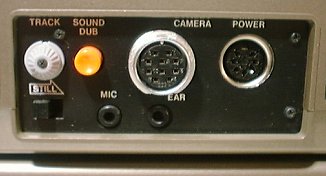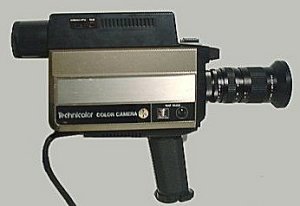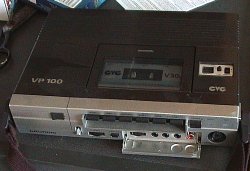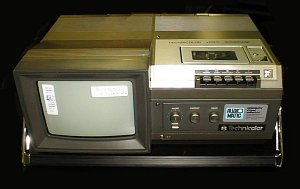 |
|
 |
|
 |
|
 |
|
 |
||||||
|
||||||
 |
 |
|||||
 |
FORMAT: CVC | |||||
DATE: 1980 PRICE: £500 [2005: £1430] 24x26x8cm 3.25kg |
||||||
 |
 |
|
|
||||||||||||||||||||||||||||||
| The contrast between this system and the Ferguson 3V01 full-sized VHS portable from the year before could hardly be greater. The compactness of the CVC cassette allows the recorder to be a fraction of the size of the equivalent VHS hardware, and also much lighter - 3.25kg, about a third of the 3V01. The CVC machine is truly portable, essentially no different in size or weight than a good quality audio recorder. A shoulder strap attaches to clips at each side, and a rubber strip around the machine protects it from handling shocks. | |
| The operating controls are piano-key in style, but activate the tape transport mechanism electronically. The normal
play, stop, fast forward and rewind are provided, and of course record - which operates on its own, without having to
press play as well.
There are no keys for picture search or pause, but a switch on the side engages still mode while playing - and in this mode the tracking knob acts as a variable-speed control, moving from still, through slow motion, to faster-than-normal playback. |
 |
| The machine has no power switch. The system is activated when a cassette is inserted, which means that a picture is only displayed on the TV if a cassette is in the machine - the CVC system was not intended to be a home deck, rather a portable system which could also receive TV signals. Thus there is no timer in the associated tuner unit. | |
 |
There was also a matching camera, though any camera of the day could have been used since a standard 10-pin socket
is fitted. The 12v NiCad battery was claimed to last 40 minutes if powering the camera, twice that for the recorder alone.
The picture quality is good, though somewhat grainier than the larger formats. The limited tape control, particularly the lack of pause-record, means that editing in the machine is not practical; the rough shots taken on location would have been edited off onto a more powerful home-deck. Audio Dub is provided, however, and both AV and RF outputs are built in. |
| Grundig also produced a machine using CVC tapes, the VP-100, which ran the tape at a slower speed than the
Technicolor to increase the recording time.
Given the inherant graininess, the inevitable drop in quality might have been a problem, but the FP100 could apparently run at several speeds, allowing you to trade off time against quality, and even to provide genuine slow motion (by recording at high speed then playing back at normal speed). |
 |
| Although available at the same time as VHS, Beta and V2000, CVC seems to have made very little impact for home use. Consumer guides at the time either ignored it completely, or described it as "hard to find". One problem was that the budding CVC videographer would have required another home machine as well, for day to day use; apart from anything else the maximum one-hour of recording would have been too limiting. Machines like the VHS 3V01 or Betamax F1 on the other hand, were truly dual function since they were essentially just modified versions of full-function home machines. |
 |
A combined portable TV and CVC recorder The first Video Walkman? |